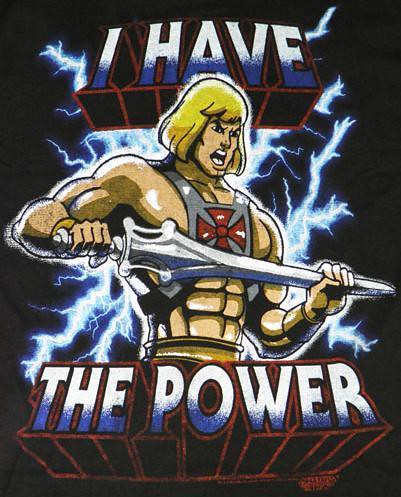
About a year ago I started using a training with a power meter and changed my life. Well...not really. But I did find it to be a really useful tool for getting faster, especially for getting the most out of the least amount of saddle time. I'm sold on it...just like He Man.
I understand that not everybody wants (and I would argue none of us needs) a powermeter and that's fine. However, it finally looks like affordable powermeters are coming to the masses and I think that's a good thing. There are a number of new products coming to market in the coming days/months that look interesting and will challenge the incumbents SRM, Quarq and Powertap.
I've been happy with the reliability of my Powertap but as a self proclaimed wheel whore I don't love being tied to a boat anchor for races or spirited group rides. Being able to use one PM for Road/CX/MTB seems like the holy grail. As more companies enter the market products will not only get better but prices will come down too.
Who's happy with their current PM, who's looking for a new dance partner and who's looking to get in the game?
Here are a few of the interesting new things coming soon:
* Stages caused a stir this week on the interwebs after their announcement they they will begin shipping their relatively low cost 20 gram Left-Crankarm-Only powermeter, which was subsequently panned by the most influential bike/tri gear reviewer geek on the web. Starting at $700 its pretty affordable and easily swapped between all kinds of bikes (assuming you have the same brand and length cranks), but some question the validity of left leg only data and possibly the precision and/or accuracy of the system.
* Garmin Vector - Will this much hyped but oft-delayed product ever actually come to market? At $1500 and only for Look Keo pedals this one looks like a non-starter.
*Brim Brothers - Shoe based powermeter initially only for Speedplay Zero pedals. Strain gauges mount on the cleat and you attach some plastic fobs to your shoes non unlike tassels on penny loafers. Upside of these is that you might be able to measure power output if, say, you are a tap dancer by day. Price $TBD. Launch date? I give it 50/50 odds vis-a-vis Garmin Vector.
*Quarq RIKEN & ELSA: Just some evolutionary changes to the current Saturn product. ELSA (out now) adds power balance (left vs. right leg) and both will now allow for changing chainrings without recalibration. List price for the base RIKEN model (shipping in late Feb) brings the MSRP down a little (now starting at around $1600 cranks included)
...And a few that have been out for a little while...
*Polar/Look Keo - Polar - a.k.a the Commodore Amiga computer of cycling. Once upon a time Polar made the raddest HRMs in the biz but now they just look like a dinosaur. At least this one is actually on the market now. So how much? $2500. Really? Does it come with around-the-clock services of a Finnish soigner for that much? Nope. But it will work with my Garmin, right? No, it only works with Polar head units. Hm. But I get the head unit with it, right? No, you have to buy that separately. Awesome.
*Power2Max: Also-ran crank based power from Germany? Terrible name (not to be confused with MAX POWER, the man whose name you'd love to touch) but has decent reviews. At ~$1000 without cranks it's half to a third the price of its German compatriot SRM. This has been out for a while but hasn't gained broad appeal in the USA relative to Quarq.
Of course you could always build your own:
http://keithhack.blogspot.ca/2013/01/v3power-meterthe-complete-how-to.html
Last edited:






